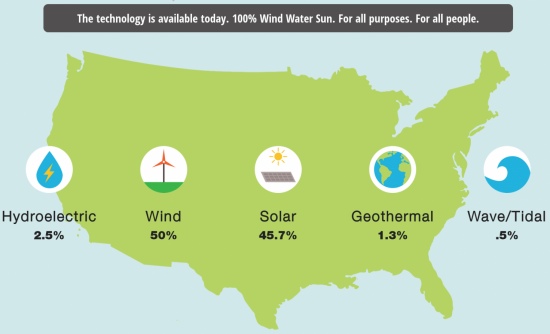forum
library
tutorial
contact

Solutions Project: Power the Planet
with 100 Percent Renewables
by Antonio Pasolini
GreenBiz, November 10, 2014
|
the film forum library tutorial contact |

|
Solutions Project: Power the Planet
by Antonio Pasolini
|
 Renewable energy is the fuel of the future -- or so it should be. Imagine a world where solar and wind power are the norm. Some people insist that it's a pipe dream, that we are too dependent on fossil fuel. How about infrastructure and materials needed to build it? It sounds like a gargantuan mission.
Renewable energy is the fuel of the future -- or so it should be. Imagine a world where solar and wind power are the norm. Some people insist that it's a pipe dream, that we are too dependent on fossil fuel. How about infrastructure and materials needed to build it? It sounds like a gargantuan mission.
In fact it is, but this does not deter visionaries who believe renewable energy can power the whole world with compelling scientific and economic evidence. Among those people are the brains behind The Solutions Project, an initiative led by renowned scientist Mark Jacobson and finance wizard Marco Krapels, whose aim is to educate the public and decision-makers about the feasibility of 100 percent clean energy. The group combines science, business and culture to develop and implement science based clean-energy plans for states and countries.
Jacobson and Krapels were in conversation with Green Biz's Joel Makower during the 2014 edition of VERGE in San Francisco (Oct. 27-30), a forum for discussion on the cutting edge of sustainability tech and applicable solutions.
"We want to get to 100 percent renewable energy around the world," said Jacobson as the conversation started. This is his message in a nutshell.
Jacobson is a well-known renewable energy pundit, a professor of civil and environmental engineering at Stanford University with experience in air pollution and climate change. In 2009, he co-authored a report on how to power the world with renewable energy by 2030. The study received widespread media attention and was featured on the cover of Scientific American in time for the disappointing UN climate conference in Copenhagen. In 2013, his group developed individual WWS energy plans for each of the 50 U.S. states.
The Solutions Project has a detailed plan on how to get to a 100 percent renewables and all the jobs it would generate. "Why is it that Walmart is covering its roof spaces with solar? Because it makes economic sense," added Krapels, board member and Pegasus Capital Advisors partner.
The duo are against nuclear and natural gas, which many see as a solution during a transition phase. "We are trying to eliminate burning. Consumers will realize that they are not getting a good deal with gas," said Jacobson. Using no combustion fuels results in a reduction of 30 percent in global energy demand as electrical processes are more efficient.
In their view, wind and solar are the stars of a clean energy future, with 50 percent and 45.7 percent, respectively. That is followed by hydroelectric with 2.5 percent of the share, geothermal with 1.3 percent while wave and tidal would account for 0.5 percent of energy generation. Shifting to renewable energy would save $510 billion in health costs as pollution would decrease and nearly 5 million 40-year jobs would be created. This page on the project's website has more facts and figures, including an interactive map with specific information for each U.S. state.
To deal with the issue of variability that critics of solar and wind often highlight, Jacobson said the key is combining renewable energy types into a bundle. Wind and solar are complementary as wind peaks at night and solar during the day. Hydroelectric, for instance, can be used to fill in the gaps.
Wind and solar are complementary. Wind tends to peak at night and sunlight peaks during the day. Using hydroelectric power as a filler, as is already common, allows demand to be precisely met by supply in most cases. Other renewable sources such as geothermal and tidal power can also be used to top up power generation.
Jacobson's argument is robust and makes sense. There are economic, health and ecological benefits. So why are we not doing it? Economic interests influence political decision, currently mostly oriented towards fossil fuels. It would take a huge collaborative effort to make the shift. Orchestrating this transition is more complex than the technology needed in the face of the antagonistic forces at work.
But the most important thing is -- 100 percent renewable energy is possible. So next time someone says that renewables cannot power the world, just point them to The Solutions Project. They may change their minds about the issue.
learn more on topics covered in the film
see the video
read the script
learn the songs
discussion forum
